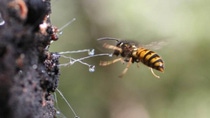Wasps wiped out in game changing conservation program

The Wasp Wipeout community led conservation program, supported by BASF, achieved significant results in reducing the invasive wasp populations in the Nelson Bay, New Zealand, region.
Program organisers celebrated at the conclusion of the 2017 Wasp Wipeout campaign following confirmation from the New Zealand Department of Conservation (DOC) feedback that nests had collapsed, populations were slashed and the drone of invasive wasps silenced in the Nelson Bay region of New Zealand.
BASF provided just over NZ$22,000 to support the programs’ 2017 and 2018 campaigns which saw wasp control operations undertaken by community groups in national parks across the Nelson region in February and March 2017.
“We are thrilled our contribution was able to help the program achieve such dramatic results,” said Dale Barron, New Zealand Country Manager, BASF.
Wasp bait was applied to hundreds of yellow stations in Abel Tasman, Nelson Lakes and Kahurangi national parks during the annual blitz on the invasive pests. There were also Wasp Wipeout operations in other recreation areas, including mountain bike and walking tracks across the region.
Post-control monitoring had found the decline of wasps saw reduction of between 95 and 98 percent.
The control program provided relief for native birds and insects which are now able to feed on the beech honeydew, which the wasps eat, and give them a chance to put on weight and prepare for winter.
Insect ecologist Richard Toft, who developed the Vespex bait used during Wasp Wipeout, using BASF’s insecticide fipronil, said the campaign had helped to generate interest in wasp control across the country.
The program, a unique community partnership between the Nelson Mail newspaper, the New Zealand Department of Conservation, the Tasman Environmental Trust, Nelson City Council, Tasman District Council and various community groups received international recognition winning this year’s Pacific Area Newspaper Publishers Association (PANPA) Environment Award. It was also a finalist in the WWF Innovation Awards and picked up an award at the TVNZ Marketing Awards.